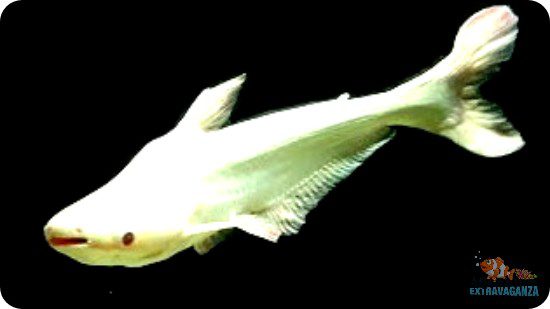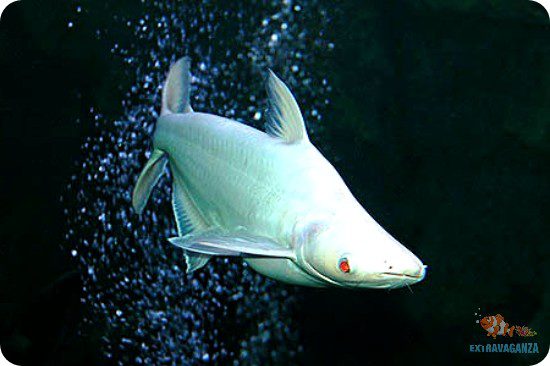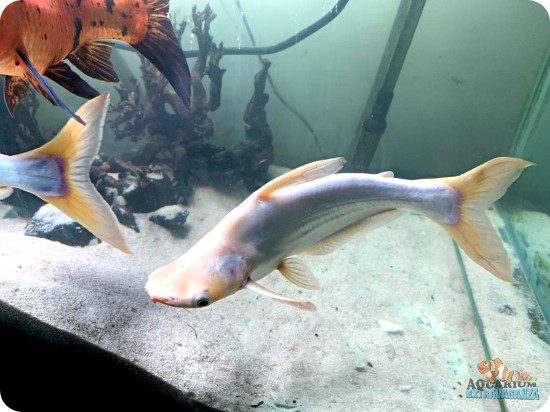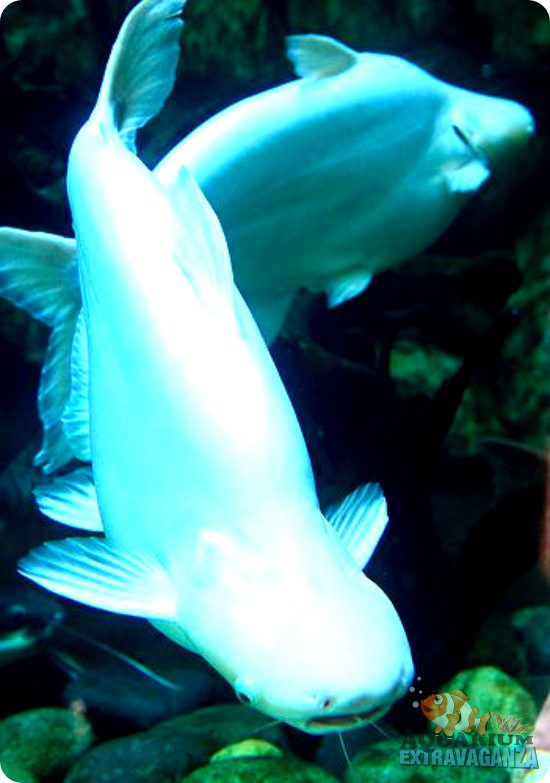Did you know that there is a rare species of fish known as iridescent sharks, which are unique for their albino coloration? These fish make great tank mates and can be fed with catfish pellets. If you’re fascinated by the wonders of the aquatic world, the iridescent sharks will surely catch your attention. These active swimmers thrive in freshwater and are best kept with compatible tank mates. Meet the Albino Pangasianodon Hypophthalmus, also known as the Albino Iridescent Shark.
This unique species of shark is commonly found in waters and is distinguishable by its iridescent scales. The Albino Iridescent Shark is a type of catfish that belongs to the shark family. It is often confused with the Swai, another type of catfish, due to their similar appearance. However, the Albino Iridescent Shark has a distinct albino coloration, making it stand out among other species of sharks Belonging to the catfish family, this mesmerizing creature, known as a shark, stands out with its stunning white hue and iridescent scales. Sharks are often found in rivers. But what makes these albino catfish and iridescent sharks even more intriguing is their rarity; these albino beauties are not commonly found in ponds or aquariums.
With its striking appearance, the Albino Pangasianodon Hypophthalmus, also known as iridescent sharks or catfish, has become a sought-after addition to many aquatic enthusiasts’ collections. The iridescent sharks, also known as catfish, bring a touch of magic to any water ecosystem they inhabit. Whether you’re an avid fishkeeper or appreciate nature’s marvels, exploring the world of these iridescent sharks and catfish will leave you spellbound.
Albino Iridescent Shark Characteristics and Appearance
The albino Pangasianodon hypophthalmus, commonly known as the albino iridescent shark or catfish, exhibits several distinctive features. The catfish, known for its pinkish-white coloration, is distinct from other varieties of this species. This includes the iridescent sharks. This unique coloring gives the iridescent sharks and catfish a captivating and eye-catching appearance.
In addition to its coloration, the albino iridescent shark, also known as the albino catfish, possesses a slender body with a forked tail fin. This streamlined catfish physique allows it to navigate through water with ease and grace. The catfish can grow up to 3 feet in length, making it an impressive sight in aquariums or natural habitats.
One distinguishing feature of the albino iridescent shark, also known as the catfish, is the presence of barbels around its mouth. These catfish sensory organs assist the fish in locating catfish food by detecting catfish vibrations and changes in water pressure. The lateral line system of the catfish, another notable characteristic of this species, runs along both sides of its body. This line consists of specialized cells that help detect movement and changes in water flow.
To summarize:
-
The albino iridescent shark has a distinctive pinkish-white coloration.
-
It possesses a slender body with a forked tail fin.
-
The fish can grow up to 3 feet in length.
-
It has barbels around its mouth for sensing prey.
-
The lateral line system helps detect movement and changes in water flow.
These unique characteristics contribute to the allure and fascination surrounding the albino Pangasianodon hypophthalmus, making it a captivating addition to any aquatic environment.
Natural Habitat and Behavior
The albino Pangasianodon hypophthalmus, commonly known as the albino Mekong catfish, is a species native to Southeast Asia, specifically the Mekong River basin. This freshwater fish is well adapted to the waters of this region, where it thrives in its natural habitat.
One notable aspect of its behavior is that it tends to be most active during nighttime. This nocturnal behavior allows the albino Pangasianodon hypophthalmus to take advantage of the cover provided by darkness, making it easier for them to spot their prey and avoid potential predators.
In its natural environment, this species exhibits schooling behavior. Juveniles can often be found in large groups or schools, providing protection against predators and increasing their chances of survival. This social behavior continues into adulthood, with adult albino Pangasianodon hypophthalmus also forming schools during specific periods.
Due to its popularity in aquaculture and trade, this species has found a place beyond its native rivers. Hobbyists from around the world have taken an interest in keeping these unique fish as pets in home aquariums. However, it’s important to note that they require specific conditions, such as a large tank with plenty of space for sudden movements and a suitable diet.
Care and Maintenance Requirements
Keeping albino pangasianodon hypophthalmus as pets requires specific care and maintenance to ensure their well-being. Here are some key points to consider:
-
Tank Size: These fish need a large aquarium with ample swimming space due to their adult size. Tanks of at least 200 cm in length are recommended to accommodate their growth.
-
Filtration System: To maintain clean water quality, it is essential to use a sound filtration system. This helps remove impurities and keeps the tank environment healthy for the albino pangasianodon hypophthalmus.
-
Feeding: Albino pangasianodon hypophthalmus feeds on live or frozen foods such as shrimp and worms. It is crucial to provide them with a varied diet that meets their nutritional needs.
-
Water Changes: Regular water changes are necessary to maintain optimal conditions in the tank. This helps remove waste toxins and ensures proper oxygenation for the fish.
Considering these care requirements will help create a suitable environment for your albino pangasianodon hypophthalmus. By providing them with adequate space, clean water, appropriate feeding, and regular maintenance, you can ensure their health and well-being as they grow into adulthood.
Albino Iridescent Shark as a Pet
-
Not recommended for beginner fish keepers
-
Requires a spacious tank due to its size
-
Can be kept with other peaceful fish species
-
The tank should have hiding spots and plants for comfort
Albino Pangasianodon hypophthalmus, also known as the Albino Iridescent Shark, is a captivating fish that some aquarium enthusiasts may consider keeping as a pet. However, it’s important to note that this particular species is not recommended for beginners in the world of fishkeeping. They require specialized care and attention to thrive in captivity.
One of the critical considerations when keeping an Albino Iridescent Shark is providing them with a spacious tank. Due to their large size, these fish need ample swimming space to move around comfortably. A tank size of at least [insert appropriate gallon capacity] is recommended to accommodate their needs.
While they may be solitary by nature, Albino Iridescent Sharks can coexist peacefully with certain other fish species in an aquarium. When selecting suitable tank mates, it’s essential to choose peaceful species that are compatible with the shark’s temperament. Some potential options include:
-
Peaceful community fish such as Gouramis or Tetras
-
Other catfish species like Corydoras or Plecos
Creating an environment that mimics their natural habitat is crucial for the well-being of Albino Iridescent Sharks. The tank should provide hiding spots and plants where they can seek refuge and feel secure. This helps reduce stress levels and promotes natural behavior.
To ensure proper nutrition, feeding your albino shark a balanced diet is essential. They are primarily carnivorous and will benefit from high-quality catfish pellets specifically formulated for their dietary needs.
Insights on Albino Pangasianodon Hypophthalmus
Albino Pangasianodon hypophthalmus, also known as the albino iridescent shark, is a fascinating species highly sought after by aquarium enthusiasts. However, breeding them in captivity can be quite challenging due to their unique characteristics.
One of the main challenges faced when breeding albino Pangasianodon hypophthalmus is their weakened immune system. This makes them more vulnerable to diseases compared to their non-albino counterparts. As a result, special care and attention are required to ensure their health and well-being.
Despite these challenges, successfully breeding albino Pangasianodon hypophthalmus can be a rewarding experience for dedicated aquarists. With proper knowledge and expertise, it is possible to create suitable conditions that mimic their natural habitat and encourage successful reproduction.
In terms of lifespan, albino Pangasianodon hypophthalmus can live anywhere from 10 to 20 years. This longevity provides aquarium enthusiasts with the opportunity to enjoy their captivating presence for an extended period.
To summarize:
-
Albino Pangasianodon hypophthalmus is highly sought after by aquarium enthusiasts.
-
Breeding them in captivity can be challenging due to their weakened immune system.
-
Their lifespan can range from 10 to 20 years.
By understanding these insights about albino Pangasianodon hypophthalmus, aquarists can better appreciate the uniqueness of this species and take appropriate measures for their care and conservation.
Iridescent Shark vs Albino Iridescent Shark
The iridescent shark, also known as the swai, is recognized for its dark gray-black coloration. On the other hand, the albino iridescent shark lacks pigmentation, resulting in its striking white appearance.
Both the iridescent shark and the albino variant share similar characteristics and care requirements. They are active swimmers that thrive in large aquariums or spacious ponds. However, their physical appearance sets them apart from each other.
Here’s a brief comparison between these two unique sharks:
-
Coloration: The iridescent shark displays a dark gray-black hue, while the albino iridescent shark stands out with its mesmerizing white color.
-
Pigmentation: While the iridescent shark possesses natural pigments responsible for its dark coloration, the albino variant lacks these pigments altogether.
-
Appearance: Due to their contrasting colors, it’s easy to distinguish between an iridescent shark and an albino one. The former showcases a sleek and mysterious presence with its dark shade, while the latter exhibits an eye-catching elegance with its pristine white tone.
Despite these differences in physical appearance, both types of sharks require similar care. They thrive in well-maintained environments with ample space for swimming and regular water changes to maintain optimal water quality. Providing them with a balanced diet consisting of high-quality pellets or live food will contribute to their overall health and vitality.
Comparison: Albino Iridescent Shark vs. Glass Albino Iridescent Shark
We discussed their characteristics and appearance, natural habitat and behavior, care and maintenance requirements, as well as insights on keeping them as pets. Now, let’s compare the two variations – the albino iridescent shark and the glass albino iridescent shark.
The main difference between these two is in their appearance. While both are stunning with their pale white coloration, the glass albino iridescent shark has a more translucent look, resembling a delicate piece of glass gliding through water. On the other hand, the regular albino iridescent shark has a more opaque white appearance but still retains its mesmerizing beauty.
Now that you have a better understanding of these captivating creatures, you might be wondering which one would make a perfect addition to your aquatic family. Remember to consider your personal preferences and aquarium setup when making your decision. Whether you choose the ethereal glass albino or the classic albino variation, both will bring an enchanting touch to your underwater world.
FAQs
Can I keep an albino iridescent shark in a small aquarium?
Keeping an adult albino iridescent shark in a small aquarium is not recommended. These fish can grow quite large (up to 3 feet) and require ample swimming space. It’s best to provide them with at least a 200-gallon tank or consider alternative species for smaller setups.
What should I feed my albino Pangasianodon Hypophthalmus?
Albino iridescent sharks are omnivores and have a hearty appetite. They enjoy a varied diet consisting of high-quality pellets or flakes supplemented with live or frozen foods such as bloodworms, brine shrimp, and small fish. Providing a balanced diet will help keep them healthy and vibrant.
How long do albino iridescent sharks live?
With proper care, albino iridescent sharks can live for 15 to 20 years. Ensuring a suitable environment, maintaining water quality, and providing a nutritious diet will contribute to their longevity.
Can I keep multiple albino iridescent sharks together?
Albino iridescent sharks are best kept in groups of three or more. They are social fish and thrive when they have companionship. However, please make sure that your aquarium is large enough to accommodate the increased number of fish comfortably.
Are albino iridescent sharks suitable for beginners?
While these fish are captivating and may appeal to beginners, they require a significant commitment due to their size and specific care needs. Beginners should gain experience with smaller species before considering an albino iridescent shark.
Are albino rainbow sharks aggressive?
Iridescent sharks are not naturally aggressive fish. They don’t defend territory or chase similar-looking fish.
Yet, their poor eyesight and curious appetite lead them to eat smaller tank mates, which can appear aggressive to inexperienced hobbyists.
Do Iridescent Sharks Have Teeth?
Juvenile iridescent sharks have teeth that they use to cut and tear meatier foods when they are young.
As they grow, they lose these teeth and start preferring plant-based foods and prey they can swallow whole.
In aquariums, these fish are enjoyable to feed.



